
Welcome to Panama
After leaving our house sit in Costa Rica, we were keen to get to Panama City. We had left ourselves only four days before our flight home to Seattle for our oldest son's wedding, and in that time we had a lot of paperwork to complete before we could leave.
When you bring your vehicle into a country on a temporary import permit, the owner's passport is stamped and registered with customs. If you were to then exit without the vehicle, you would be liable for paying import tax. In some countries this could be the value of the vehicle. The only way to avoid the tax is to store the vehicle in an approved lot under the control of the customs agency--an almacen fiscal.
Since we'd never done this before, and with a weekend between our leaving Costa Rica and when we had to board the plane, we were understandably a bit nervous. Should anything go wrong, Karen would be on the plane alone, leaving me to work out the details. Of course, we weren't about to let that happen!
Crossing into Panama was just another border with the typical bureaucratic red tape, and to be honest, we had become so immune to the process that we hardly remember the details. Little did we know that six hours later we would find ourselves in deep, deep trouble.
At the border, Karen had been sending messages to the kids, and in her last message before the border, she had casually remarked how nervous she was. What she meant was that she was concerned about getting to Panama City and getting the customs blessing to leave for home.
Unfortunately, once we were in Panama, our local SIM cards from Costa Rica didn't work, and so we basically went "dark", and unbeknownst to us, our kids were working up a fret. Our son Andrew had a roommate from Panama who had told him the country was really, really dangerous. Thus, when Karen said how nervous she was and then didn't reply to the kids' responses, we inadvertently set off an avalanche of worry. Simply put, our kids freaked out.
Here is the exchange:
Brian (11:35 AM): “Make it through?”
Two hours later:
Andrew (1:45 PM): "Doesn’t sound like things are going well. Need me to call the embassy? Please respond Momma, Papa. Oh, and I forgot to tell you I love you."
Brian: "They’re in Panamanian prison. For sure. Tried calling them. Nada. Wonder if their SIM card doesn’t work. Six hours since last message – they have to be through by now."
Andrew (2:36 PM): "Has it really been six hours? Can you check their SPOT [tracking device]?"
Then, a few minutes later:
Brian: "SPOT says they’re off the coast of Africa."
Andrew: "LOL. Somali pirates in Panamanian waters? At what point do we call the embassy? Tried calling, number disconnected. Fucking classic. Plane tickets are a thousand dollars. I’ll go Rambo if needed. I’m mainly worried because my roommate said the border is the choke point for drug traffickers. Any border is probably the place where people get targeted most."
Brian: "Maybe the wedding next week will also be a memorial service."
A little after 3 PM we reached our hotel campground. Once we got connected to WIFI, our phones lit up.
Karen: "Sorry, we had no cell."
Andrew: "Jesus. Finally. Just made a post on your Facebook and sent an email to the US embassy. Jerms. Jerks."
Brian: "Finally. A-holes. Fifty pushups."
Andrew: "Yeah, and an essay please."
Brian: "I was thinking about never having to work again in my life and where Andrew, Lyss and I would buy a cheap beach bungalow."
Alyssa (3:28 PM) : "OMG I just read all these. Glad you’re safe."
Brian: "Seven days until we can give dad a noogie."
After the kids simmered down, we found out that their Facebook post had set off an additional cascade of worry from our friends. It took a lot of soothing to convince everyone that we were fine.
In Panama City, we headed straight to the Crowley customs yard. There we were told that the yard was being moved, and Crowley couldn't take the truck. Now what?
Luckily, the agent gave us the name of a second company, Panalpina, which provided the same service.
Twenty minutes later we pulled into the Panalpina yard. Although the yard seemed a rather bleak facility, we took it on faith that the wire-topped fence and twenty-four hour security would keep us safe. It was a customs yard, after all.
We met the general manager, Antonio Rivera, who was very friendly and helped us arrange all the papers we needed to get the exit stamp to leave. Twenty minutes later the truck was parked and locked. I turned over the keys, and we were off to the customs office in Curundu. The officers at customs were friendly and helpful, and fifteen minutes later my passport was cleared for departure!
Old Town Panama City
With a couple days before our flight home, we opted to stay in Casco Antigua, the old town neighborhood. Casco Antigua (or Casco Viejo as some refer to it) is full of beautiful colonial buildings and has a great view across the bay to the downtown financial district. One of the first Spanish settlements in Panama, the neighborhood has been designated a UNESCO World Heritage site.
Many of the old buildings have been restored to their former glory. The rest seemed destined for renovation.



I enjoy finding and photographing the "forgotten places"--areas which haven't yet met the wrecking ball. They always seem to have a certain "colorful" character you can't find anywhere else. Unfortunately, in Casco Viejo, with so much remodeling work going on, these places are become scarce.
A Visit to the Miraflores Locks
With only a day before our flight home, we had to be selective about which sights to see. Normally we tend to avoid the big tourist draws, but no visit to Panama is complete without a tour of the Canal Zone.

We arrived at the viewing gallery just in time to catch the last boat of the morning coming through the locks.
A marvel of engineering and construction, the original canal has now been augmented with a second waterway, capable of handling larger ships with up to two times the cargo capacity. Even the "small" ship we saw was impressive.
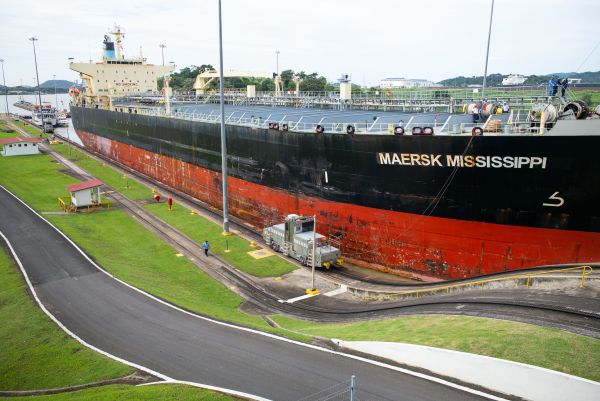
I think the shore-starved crews enjoyed seeing the tourists as much as we enjoyed watching them slide by.

The next morning we were on the plane home for the wedding. With rainy season in Panama we were in no hurry to return, so we decided to stay a couple months and tour the Rocky Mountain west. You can check out that little side trip here.
Panama City, a Study in Contrast
When we had first entered Panama, we were focused on two specific goals: get home for the wedding, then return and prepare the truck for shipping to Colombia. Now, back in Panama City, we contacted a shipping agent, who told us there was a boat departing the next Saturday. With the rainy season still in full force, we opted out of touring more of the country, and booked a container for the truck. In hindsight, it would have been nice to have spent more time in Panama, but the decision was made.
Again we stayed in Casco Viejo. We had become familiar with the area and enjoyed its convenient location; the upscale restaurants and bars were an added bonus.
Panama City is a city of contrasts. The downtown core is a glittering monument to what one can do with concrete, steel, and glass.


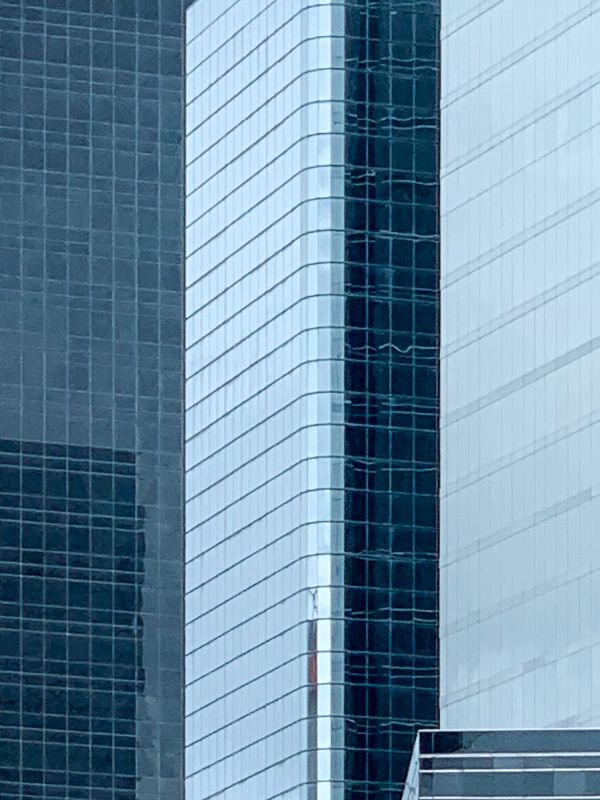
A beautiful thoroughfare borders the water and the parallel pathway offers bikers, joggers, and strollers a place to enjoy the fresh sea breeze.

We took a long stroll along the pathway from Casco Viejo all the way to the financial district. With the intense heat from the tropical sun bearing down, we were glad for the even the minimal shade of the palm trees.

On Sundays, the highway is closed to vehicle traffic, and many of the city's residents take full advantage of the opportunity to bike along the empty roadway.

As a capitol city, Panama City sure delivers on the "modern metropolitan" front, but as one of the New World's first settlements, there's plenty of "old" to be had. For the most dramatic example of the contrast, the original Spanish settlement, now called Panama la Vieja, is worth a visit. Here you can see the vestiges of the country's 16th century past.

Founded in 1519, the settlement was one of Spain's most important in the New World. Between 1500 and 1650, Spain shipped some 181 tons of gold and 16,000 tons of silver from the New World, much of it transported by land across the narrow isthmus of Panama to the Caribbean side. There the bounty was loaded onto ships bound for Spain. In today's market, that would be worth about $11 billion.
Although $11 billion doesn't seem like much for 150 years worth of effort, realize that the world economy back then was much, much smaller. When Sir Francis Drake raided a few ships during his 1577-1580 circumnavigation of the world, his haul was nearly the equivalent of England's annual revenue.
Panama City is not all quaint neighborhoods like Casco Viejo, or modern architectural wonders as in the financial district. There's a rich blend of old and new and in between, both upscale and downscale. It is a vibrant city, full of color and life.

One afternoon we connected with a local who provides cultural tours of some of the old neighborhoods, included the ill-reputed barrio, El Chorillo.
El Chorillo was the original residential area for workers who were building the canal. More recently, it was the location for Manuel Noriega's Panamanian Defense Force, which the US bombed in a short-lived invasion in 1989.
After the invasion some restoration work was completed, but the area never fully recovered. For the next two decades, as the neighborhood became a crime-ridden center for drug and sex trafficking, five distinct gangs operated there.

Although all the locals we talked to had warned us away from El Chorillo, we've come to believe that bad reputations are very hard to shake, and once you do a little investigating on your own, a different story often emerges. Our guide Victor confirmed our belief.
According to Victor, when he started doing cultural tours to El Chorillo three years ago, the police were very wary of his presence, and warned him to keep tourists away. Undaunted, Victor continued to gain the confidence and trust of the police and the locals. Now he provides a rich, cultural experience for those with the right mindset.

Our tour started off with a stroll through Santa Ana. Bordering both Casco Viejo and El Chorillo, Santa Ana was the city's original China town. Although much has changed since the original inhabitants made it their home, the neighborhood still shows vestiges of its not so distant past.

Like many cities in Latin America, Panama City has its share of wonderful street art, called "graficas." Santa Ana has some of the nicest examples of the colorful murals.

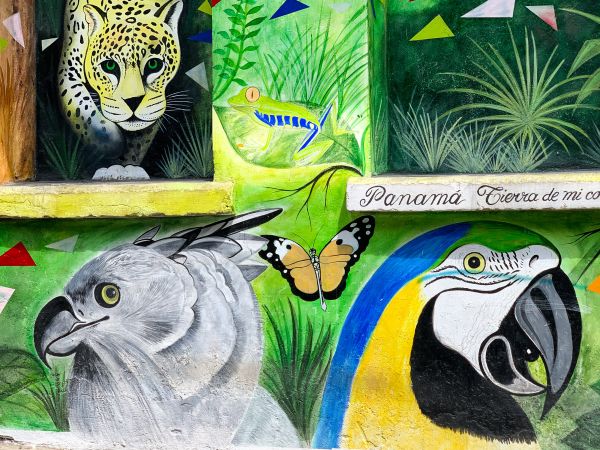

As we entered El Chorillo, the "scenery" changed dramatically. In addition to the newer cement block buildings, many of the original wooden structures were prevalent. Most of both types were in need of some serious TLC. Still, in my opinion, these buildings possess a raw beauty of their own.



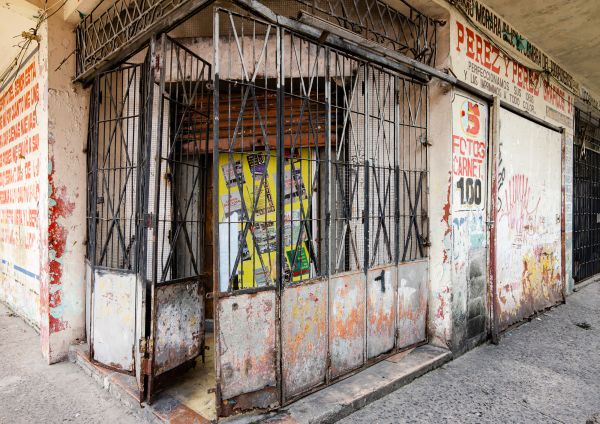


Not all of El Chorillo is urban grit and grime. A new cultural center is being built, and we passed a couple of nicer apartment buildings.

One apartment had a beautiful, well-kept playground for the kids, and a nearby soccer field was being refurbished, hinting to a brighter future for El Chorillo.
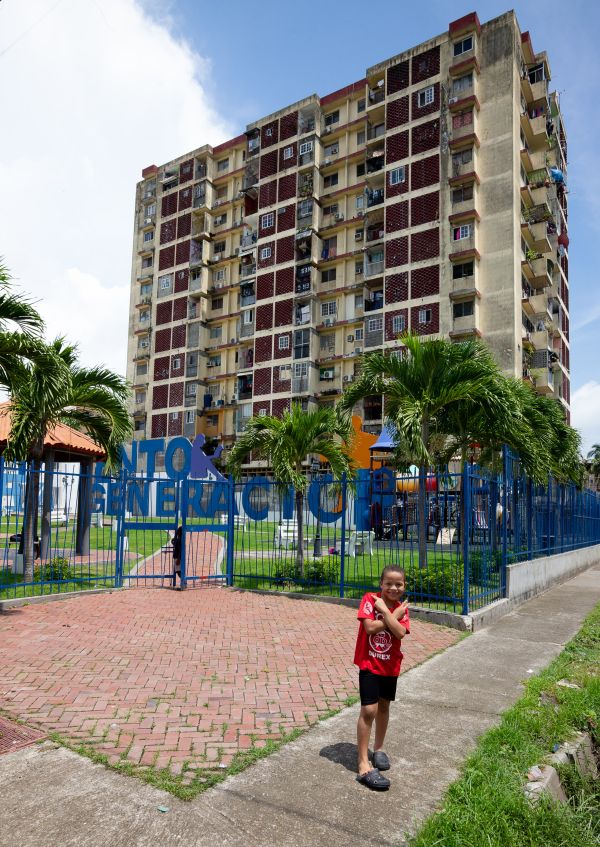
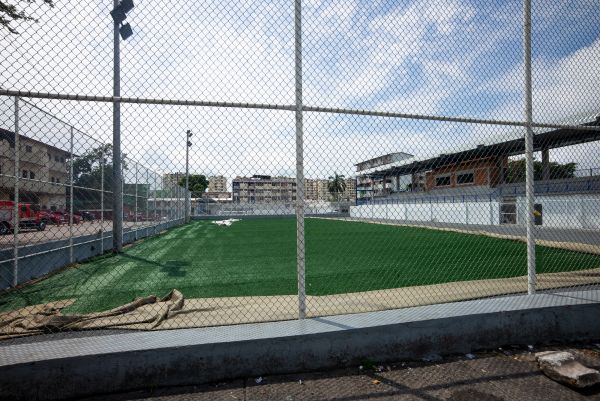
Apart from it's seedy reputation, El Chorillo is well known for producing some of the country's top sports heroes, including football (soccer) legend, Rommel Fernandez Gutierrez. Rommel was the second Panamanian player to play in the European league, entering at the young age of 21. Six years later, his starlit career came to a sudden and tragic end when he was killed in an automobile accident.
Victor explained that every Saturday, local residents congregate at Plaza Amador, where a shrine honors Fernandez' memory. According to Victor, some of the country's biggest stars often turn out to mingle with the residents and share in music, dancing, and barbeque.

We found another mural commemorating our own favorite Panamanian footballer, Roman Torres, former defensive back for the Seattle Sounders.

Of course, the most famous local sports hero of all time is boxer Roberto Duran. Duran trained in a neighborhood gym, and the training facility is still in operation today.

As we walked through El Chorillo we had several opportunities to meet the less famous residents. These schoolboys were just getting out of class, and absolutely had to have their photo taken. Kids seem to be the same everywhere, no?

We made a brief stop at the so-called "Parque de los Aburridos" (Park of the Boring). I don't think any of the men would think they're boring, but they did seem to be enjoying idling away their spare time with friendly games of dominos.

Victor seemed to know a lot of the people at the park, and we were often greeted with friendly smiles.
Macdonald, an 80 year old who used to live and work in the Canal Zone, now makes El Chorillo his home. And guess what ladies? He's single!

Just down the street from the park, the "singing barber" of El Chorillo invited us in for a mini-concert. Had we not been on a schedule to finish our tour, I would have jumped into the barber's chair!

In addition to his tours of the neighborhood, Victor is also giving back immensely to the community. He provides free English classes, and has set up a safe learning and play place in the neighborhood's police station. Most recently, Victor was offered a big storeroom next door to the precinct office where he could expand his offerings. With a little funding Victor could create something really special for the people of El Chorillo.
Our tour ended back in gentrified Casco Viejo, where we thanked Victor for showing us the "other side" of Panama City. We promised to help promote his tours, which we believe can break down the social and cultural barriers separating locals from tourists.
We hope if you are ever in Panama City you put aside any fears or social prejudices you might have, and sign up for one of Victors tours. You can contact Victor on Instagram at @localinpty. He also has a Facebook page #localinpty.
Shipping to Colombia
A few hundred kilometers east of Panama City, the Pan-American Highway comes to a sudden stop. Beyond Yaviza lies a roadless tract of land--the infamous Darien Gap. I would have said "impenetrable", but the fact is, the area does have trails--trails used by human and drug smugglers. African refugees seeking to immigrate to the United States follow this path up from South America, and armed gangs operate in the area, preying on the weak and desperate. It is a dangerous, lawless region.
Over the years, there have been occasional intrepid explorers who have braved their way across in jeeps and motorcycles. Not us. With passage south impossible, we planned to send the rig via container ship to Colombia.
Shipping a vehicle requires a fairly complicated process, and while you can certainly manage the steps on your own, to make things easy and to minimize stress, we chose to use an agent.
Soon after arriving back in Panama, we contacted Boris of Evergreen Logistics.
The first step in the process is a police inspection in Panama City to confirm the vehicle's VIN and registration. The police can only do 25 inspections per day, and most of those slots are filled by locals registering new vehicles or transferring ownership. Boris advised us to get to the inspection yard early to get in line.
We showed up at 5:30 the next morning, secured our number (nine), then joined the others waiting for the inspections to start.

The inspections started promptly at eight. Once our number was called an hour later, our inspection took only three minutes to complete.
Next, we had to report to the Judicial building at 2 PM to pick up our report. This process also involved a bit of a wait, but not long after 2PM our name was called, we received the report, and we were out the door.
Now we had to get to Colon. Panama City is surrounded by a network of automated toll roads, which can only be used by Panamanian residents who have an electronic sticker on their window. That meant we had to take the two lane road, and right during the peak of the afternoon rush. Instead of an hour and a half breeze down the freeway, we endured a three hour ordeal on narrow, two lane roads packed with traffic.
As we drove the road east of Colon to our campground, we caught the barest glimpse of what looked to be a most beautiful stretch of coast. Arriving just as the sunset was wrapping up, we felt a tinge of regret we hadn't spent more time in Panama. Another day, perhaps.
The next morning we met our agent on the outskirts of town and followed him to the loading facility.
How did we get the truck and camper into a container? First, I drove up onto a flat-bed truck.

With the rig secured onto the flatbed, the driver lowered me to a level position. I was nearly hanging off the end!

Next, the truck backed us up and carefully inserted the rear of the truck and camper into the container. This was the trickiest part of the operation, as I had only an inch or two of clearance on each side. While the driver maneuvered me in, I could only sit there, helplessly hoping his aim was good.
With directions from the helper, I slowly backed off of the truck until I was well into the container.

Once inside, the only way I could escape was to open the passenger side window and climb out over the hood. Had I gone in forwards, I would have had to squirrel myself out underneath the truck.
Finally, the helper lashed us down with a few cinch straps. I was a bit concerned the truck might shift en-route, but at that point there wasn't much we could do except hope for calm seas and a smooth passage.
With the truck nestled into the container, papers signed and fees paid, we caught a bus back to Panama City for the night. In the morning we made our flight to Cartagena to await a happy reunion with our rig.

Although we hadn't seen much of the country other than Panama City and the route to Colon, we had a pleasant stay in what I can honestly say was our favorite capitol city in all of Central America. From the clean, modern downtown to the UNESCO world heritage neighborhood of Casco Viejo, to the local "color" of El Chorillo, we had come to learn and love this gem of a city. If the rest of the country is as beautiful and diverse as its capitol, Panama should be on every traveler's bucket list.
For us, it was time to say goodbye to Central America and start the next phase of our journey.
South America, here we come!